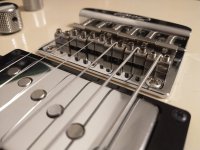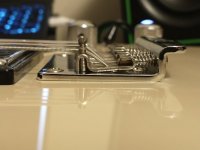JackOfBlades
New member
Sterling Valentine owners: do you have issues or struggle trying to setup a low action on your Valentine?
I can't get lower than 1.70 mm on my high E string and after studying the structure of the guitar, I'd like to hypothesize it could be due to the thickness of the bridge plate (it measures 2.40 mm, when it could be between 1.80 and 1.25 mm thick, for example) and maybe the angle of the intonation screws going into the saddle (it's around 30°, instead of being 90° straight into the saddle) affects that a little. The neck is dead straight, with a very, very slight and healthy concave relief.
My current setup is 1.50 mm on my low E and almost 1.75 mm on my high E while maintaining the 9.25 radius of the fretboard. My goal is to make it 1.25 on the high E. Keep in mind, the saddles on both the high and low E are almost hitting the bridge plate, so they won't go any lower.
Possible solutions are shimming the neck or changing the bridge all together to one with a slimmer plate (I'm considering Hipshot's hardtail .125 bridge plate).
Thoughts?


I can't get lower than 1.70 mm on my high E string and after studying the structure of the guitar, I'd like to hypothesize it could be due to the thickness of the bridge plate (it measures 2.40 mm, when it could be between 1.80 and 1.25 mm thick, for example) and maybe the angle of the intonation screws going into the saddle (it's around 30°, instead of being 90° straight into the saddle) affects that a little. The neck is dead straight, with a very, very slight and healthy concave relief.
My current setup is 1.50 mm on my low E and almost 1.75 mm on my high E while maintaining the 9.25 radius of the fretboard. My goal is to make it 1.25 on the high E. Keep in mind, the saddles on both the high and low E are almost hitting the bridge plate, so they won't go any lower.
Possible solutions are shimming the neck or changing the bridge all together to one with a slimmer plate (I'm considering Hipshot's hardtail .125 bridge plate).
Thoughts?




